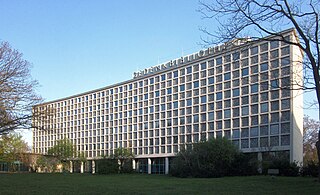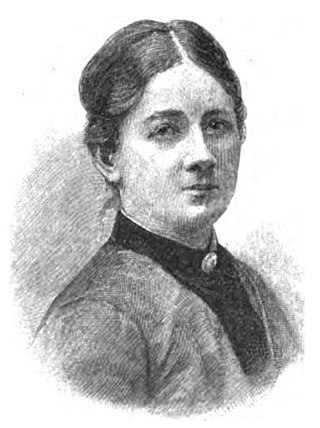Related Research Articles
Fritz Bamberger was a German Jewish Scholar, educator and magazine editor who directed the school system for the education of Jews in pre- World War II, was the editor-in-chief of Coronet starting in 1942, and taught and wrote in the areas of philosophy and intellectual history.

Alice Masaryková or Alice Garrigue Masaryk was a Czech teacher, sociologist and politician. She is a prominent figure within the field of applied sociology and known to many as the daughter of Tomáš Garrigue Masaryk and the First Lady of Czechoslovakia.

The Amerika-Gedenkbibliothek is one of the largest public libraries in Berlin, Germany. It was co-financed by a donation from the United States. The building was designed by American and German architects, including Fritz Bornemann and Willy Kreuer. It was opened on September 17, 1954, and was originally planned to become the Central Library of Berlin.
Frieda Wunderlich was a German sociologist, economist and politician of the German Democratic Party. She was actively involved in the women's movement fighting for gender equality.
Erna Lendvai-Dircksen was a German photographer known for a series of volumes of portraits of rural individuals from throughout Germany. During the Third Reich, she also photographed for eugenicist publications and was commissioned to document the new Autobahn and the workers constructing it.
Susanne Charlotte Engelmann was a German professor of education, a Protestant of Jewish descent, who emigrated to the United States following the rise to power of Adolf Hitler and the Nazi Party.

Charlotte Bühler was a German-American developmental psychologist.

Helmut Müller-Enbergs is a German political scientist who has written extensively on the Stasi and related aspects of the German Democratic Republic's history.
Trude Richter was a writer, literary scholar and teacher who became a political activist. She spent many years detained in labour camps in the Soviet Union, but she remained a committed Communist throughout her life.

Dr. Willy Cohn was a German historian and teacher. During the Nazi era, he documented the Jewish life in Breslau in his diaries, until he and his family were deported to German-occupied Lithuania and killed.
Karl Günther Ernst Felix Becker was a German art historian, best known today for the project Thieme-Becker.

Susanne Philippine von Nathusius was a German portrait painter who worked in Halle and Paris.
Rachel Zipora Dror is a German Jewish teacher and Holocaust survivor. After returning from Israel to live in Germany in 1957, and more intensively since her retirement from teaching in 1986, she has come to wider prominence because of her engagement for Christian-Jewish-Islamic co-existence, and as an advocate for religious openness and mutual tolerance. She turned 100 on 19 January 2021.
Gertrud Herzog-Hauser was an Austrian classical philologist. She was specialised in ancient mythology and religion as well as Latin literature and published Latin school textbooks. She campaigned for equal rights for women in education.
Herbert Arthur Strauss was a German-born American historian.
Christine Fischer-Defoy is a German woman writer, film director and cultural historian.

Paula Salomon-Lindberg was an internationally renowned German classical contralto before the Second World War. She was specialised in Lied, oratorio and cantata, but occasionally also performed opera.

Natalie von Milde, Natalie Haller until 1881 was a German writer and feminist. She was an adoptive daughter of Rosa von Milde (1827–1906) and Hans Feodor von Milde (1821–1899).
Leonie Adele Spitzer was an Austrian writer, poet, and educator.

Marie-Elisabeth von Humboldt was born on December 8, 1741 in Berlin and died on November 19, 1796 at Tegel Castle. Born Colomb, widow von Holwede, she was the mother of Wilhelm and Alexander von Humboldt, born from the union with Alexander Georg von Humboldt her second husband.
References
- ↑ The National Archives at Philadelphia; Philadelphia, Pennsylvania; NAI Title: Declarations of Intention for Citizenship, 1/19/1842 - 10/29/1959; NAI Number: 4713410; Record Group Title: Records of District Courts of the United States, 1685-2009; Record Group Number: 21
- ↑ Christine von Oertzen, Strategie Verständigung – Zur transnationalen Vernetzung von Akademikerinnen 1917–1955 Göttingen 2012, biographical appendix. Also the following.
- 1 2 3 4 Oertzen, Strategie Verständigung, p. 308.
- 1 2 Oertzen, Strategie Verständigung, p. 333.
- ↑ Oertzen, Strategie Verständigung, p. 326.
- ↑ Oertzen, Strategie Verständigung, p. 320f. Also the following.